Boost Settings for high outs.
Hi Everybody!
I have some question regarding the settings for my JBL 3731(3732) in bi-amp for the high out in the dbx260.
But, first some pictures and measurements.

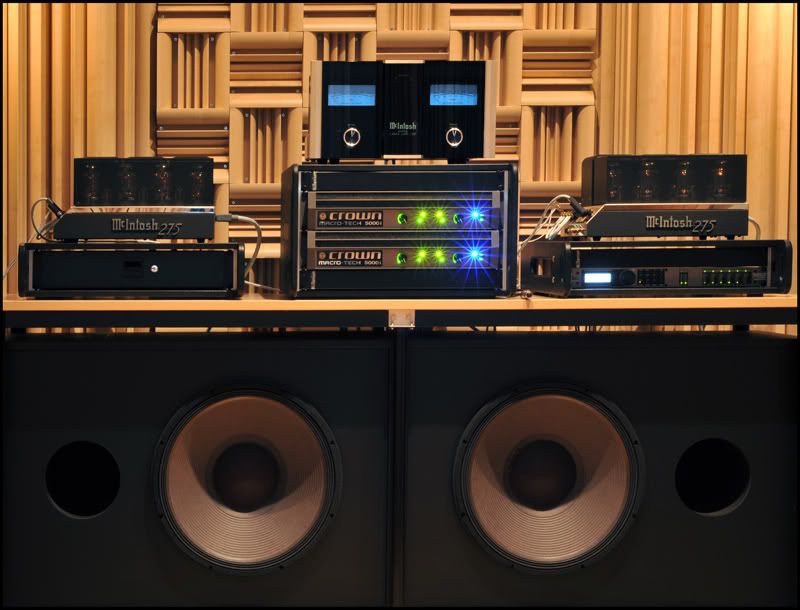
So you now how it looks, acoustically.
and now some measurements....
Here one can see the x-over settings and the freq response at the listening position.
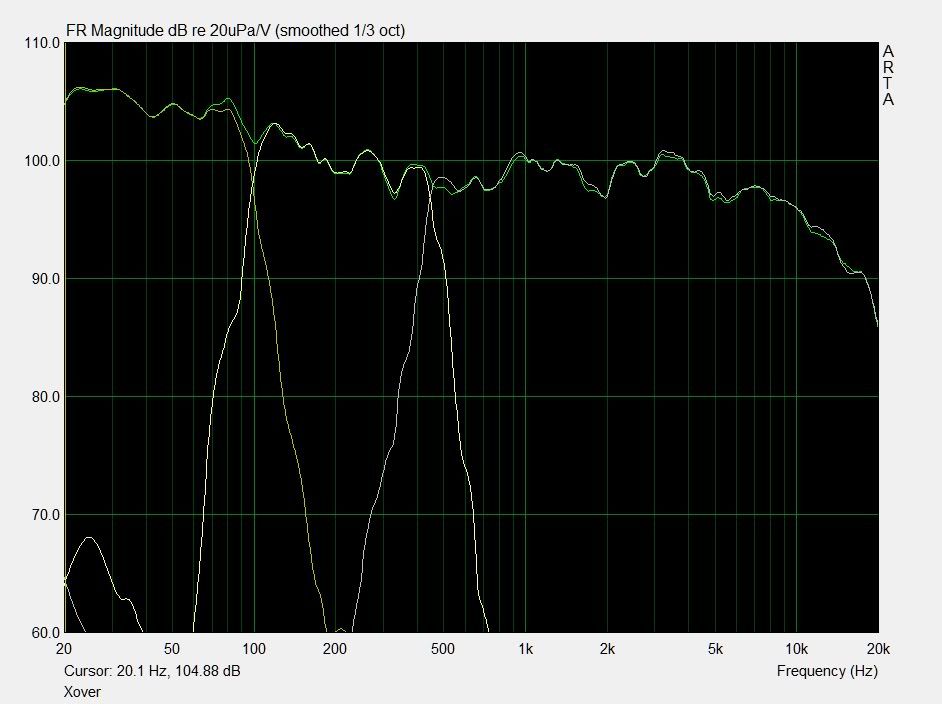
Ok, now to the questions.
This is the settings file for the high out 3732
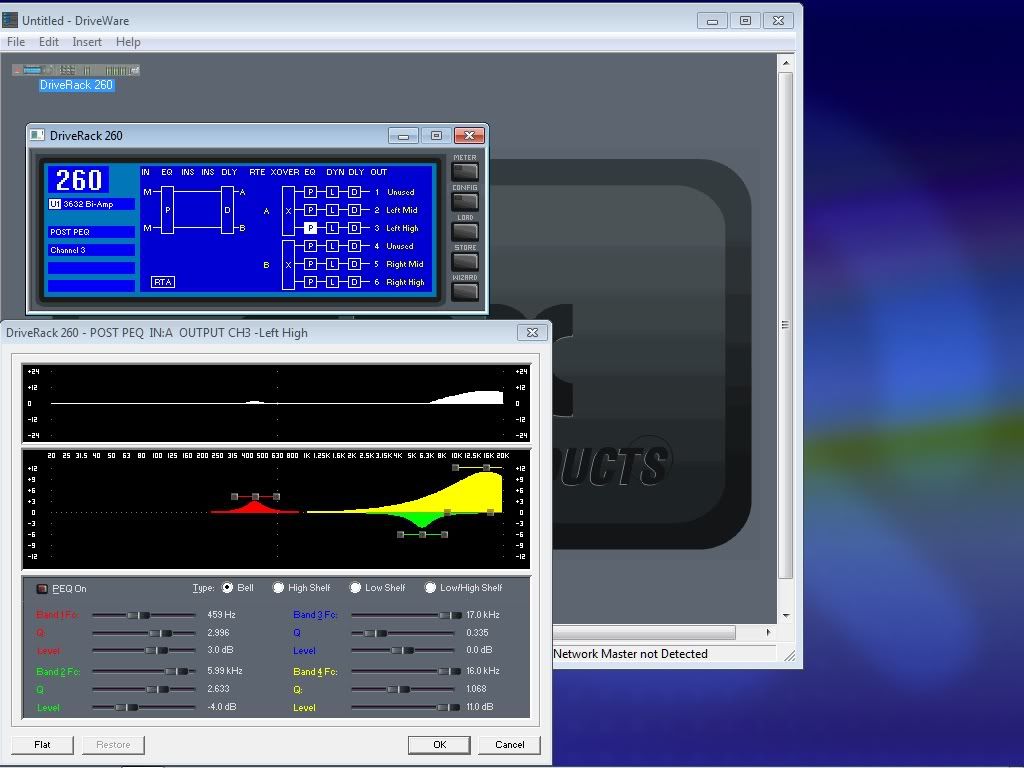
and the differences with and without the green and the yellow settings in the above picture, I get like this in my measurement at the listening pos.
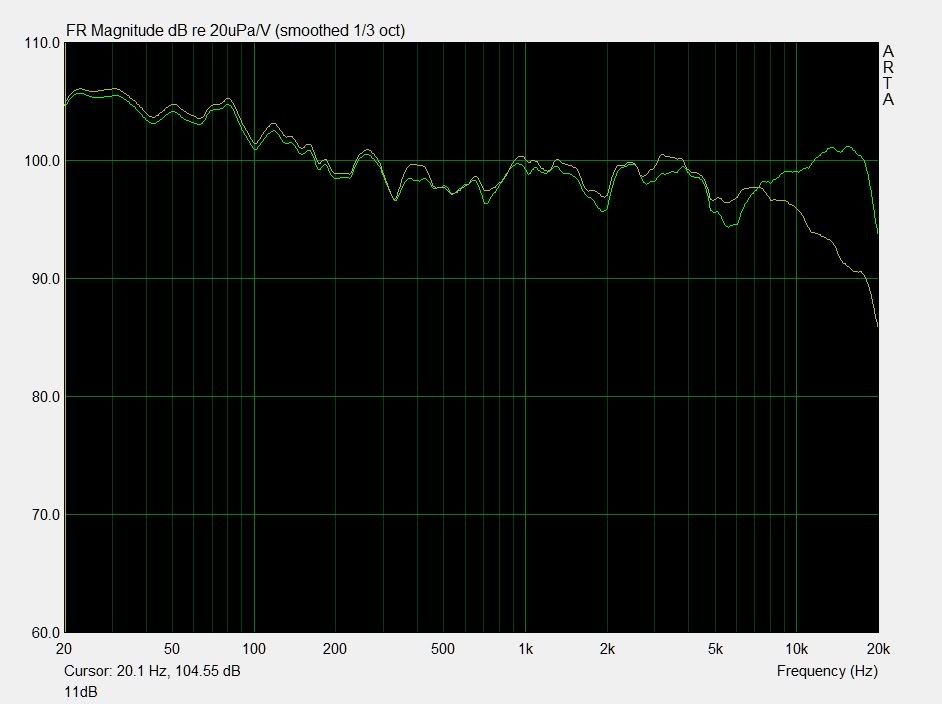
So now, what is correct here. Shall I use this setting or not??
Is this something for the compensation of the horns due to screen and air losses in cinemas. Or, is this setting for the loudspeakers tuned in a anechioc chamber. I really want to know if this is importent or not for the performance of the loudspeakers. What is the general idea and when i look at all of the settings in the dbx260, they all have this boost for all of the Cinema Screen Arrays. It is same for the dbx4800. Can somebody please explain it to me??
My feeling is and I have been tested back and forth with and without this boost and it sounds better with this boost despite the bump in the freq response. Don't just tell me to use this boost without any explanation.
Other than this, I understand the rest.
Here is another view.

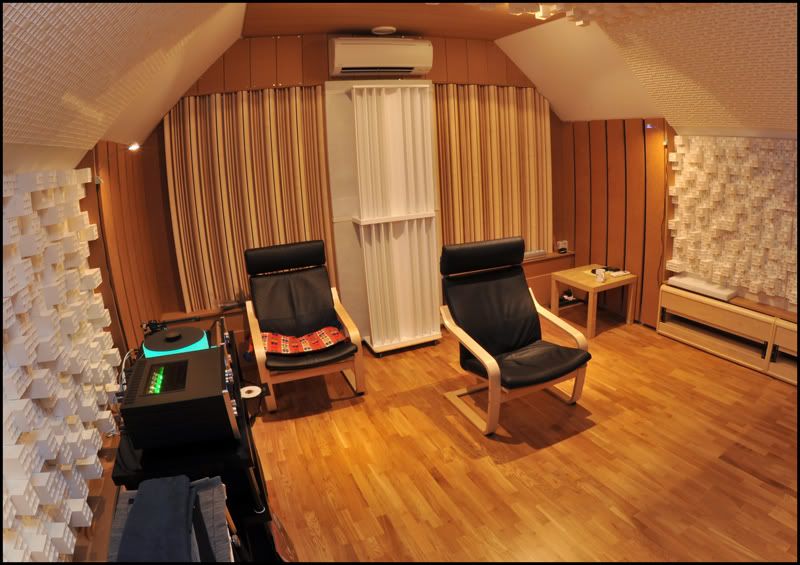
Thanks
I have some question regarding the settings for my JBL 3731(3732) in bi-amp for the high out in the dbx260.
But, first some pictures and measurements.


So you now how it looks, acoustically.
and now some measurements....
Here one can see the x-over settings and the freq response at the listening position.

Ok, now to the questions.
This is the settings file for the high out 3732

and the differences with and without the green and the yellow settings in the above picture, I get like this in my measurement at the listening pos.

So now, what is correct here. Shall I use this setting or not??
Is this something for the compensation of the horns due to screen and air losses in cinemas. Or, is this setting for the loudspeakers tuned in a anechioc chamber. I really want to know if this is importent or not for the performance of the loudspeakers. What is the general idea and when i look at all of the settings in the dbx260, they all have this boost for all of the Cinema Screen Arrays. It is same for the dbx4800. Can somebody please explain it to me??
My feeling is and I have been tested back and forth with and without this boost and it sounds better with this boost despite the bump in the freq response. Don't just tell me to use this boost without any explanation.
Other than this, I understand the rest.
Here is another view.


Thanks
0
Comments
Do your ears pop when you go in there? Or does the floor give you enough reflection?
NICE!
DRA
So -- what you are saying is that you have called up the preset for your speakers in the 260 & that is what is shown? I see your amp input sensitivity knobs are wide open. Hopefully the 260 has them compensated at the XO outputs. The live trace confirms that they are not out of balance that much.
I question the crossover alignments simply because you shouldn't have a dip there but instead "Summation". Does the preset have DELAY compensation already programmed? If there is NO delay activated -- this may be why there are dips at both XO points.
I am no studio speaker or home theater expert BUT I know the same concepts apply here like they do with live music. I just don't like the look of the trace BUT I don't know the steps you took to get that measurement. Center of room -- both speakers on? The room could be masking the true response so there is a lot to consider here.
Glad you liked it.
Just to clarify....
The program I use is ARTA and I am measureing the overall room response at the listening pos with both speakers and subs.
I am not trying to adjust the speakers response because this is allready done via the 3732 Bi-amp file. The only deviation from that file is between the subs 18" and bass 15". Here I have set the lowpass for 18" to 80 Hz LR48 and highpass the 15" to 100 Hz LR48. This gives me the flatest response at the listening pos, so far. No delay in between these cabs because it is align at the same line, as one can see at the picture. The only delay I have is for the 15" set to 0,4 ms according to the file.
The 15" is in stereo and the two 18" is connected from 260 mono out to y-link in to Crown and dual out to subs to get the subs in mono.
The phase issue is irrelevant at the listening pos because one don't know if it is room releated or not, as I see it.
The Crowns is set to 32 dB Voltage gain(2,55 Volts input sens) and yes they knobs is on max. The XO gain for the 18" is set as the same for the 15", witch is -5dB. According to my Gain structure this was the best setting.
So why the boost on all of the files for the Cinema Screen Arrays.
Is this for CD horn compensation???
Can one use shelving on the PREPEQ to adjust the response at listening pos and leave the setting as it is on POSTPEQ.
Thanks
You say the boost sounds better to you. That would be a good reason for using it.
Also, when you look at the screen shot, you see a high end boost...a bump at 16kHz. When I look at the same screen shot, I see a flatish response with a big cancellation at 6kHz. I would focus on the cancellation.
"Can one use shelving on the PREPEQ to adjust the response at listening pos and leave the setting as it is on POSTPEQ."
What do you hope to accomplish by using 2 filters to do the job of one?
So it means I can't do this, and why?? My thinking is to leave the postpeq according to the file, I asume it is a setting from JBL for this speakers and use the prepeq to flatten out the room response.
The suckout I get at 6k and the boost at 16k is due to the setting file. So,why is it implemented in the file in the first place, this is what I try to understand. There must be some reason why there is a setting file.
So you mean that you want to boost rather than cut at 6k, if so, why? Then the setting file is not so imported anymore, I hope you follow me.
Thanks
I'm not sure the dip at 6K is EQable....it looks like a phase cancellation thing maybe caused by your beautiful hardwood floor. I saw the EQ cut at that frequency but I dont think you can cure the problem by removing the cut. And I hesitate to boost.
The JBL tuning for your speakers is one person's opinion and their interpretation of the data. That persons opinion is probably a darn good one but the results are not carved in stone.
DRA
For fun -- throw a rug out onto the floor and see if your response changes. Like dips in the response down in the low mid frequencies. Place a few things around the room and see if it affects your response. You could probably correct some of the issues you are seeing by manually doing this instead of messing with the EQ.
Well, how does the system sound?
Mctwin -- you are going to get a different reading for every foot of distance you place the mic at. So if you want it to be perfect in ONLY one spot -- you may be able to do it but it won't be right anywhere else. If you want it to be right over the general listening space -- you will have to make compromises.
How many factory tunings did they come up with AND where at in the 260 are they located -- PRE input tunings (I doubt it) OR are they all located in the POST Crossover PEQ section?
G
Also, that horn pattern fires at that wall next to it does it not? At least in it's assumed 90X40 pattern...those frequencies would reflect off and spray all over and could be one source of the cancellation you are experiencing. Since the dip is in the 6khz area..and that is right in the horn range... :?:
Gadget
First I would like to say that the sound is great. To answer your question; I have my mic on a stand about ear hight when i am sitting down. I always measure at my listening position to get the best freq reaponse at this position.
Gadget; there is nothing hitting at that distance, 5,7167 mm, not the floor or the side wall or the ceiling.
I don't need any carpet on the floor and I have no reflection problems because of the diffusion and I don't have any bass resonanse or ringing and no visible absorbtion in this room.
If we take the acoustical treatment to the side a bit and concentrate on the issue about the boost.
I still have POSTPEQ according to the setting file and I have inplemented PREPEQ settings as well as you can see on this measurements I just did one hour ago. PREPEQ is made in all haste, I can fintune it a little better. The green line is with PREPEQ and the brown line is without PREPEQ.
Dr.J; you wrote
"How many factory tunings did they come up with AND where at in the 260 are they located -- PRE input tunings (I doubt it) OR are they all located in the POST Crossover PEQ section?"
All of the Cinema Screen Arrays have this setting on POSTPEQ. That's why I am asking the quaestion??
Thanks
If you mean 18" sub then it is 1,55 meter and yes I have Helmholtz resonators behind the sub/speakers. About the horn pattern fires at that wall, (I asume you mean side wall) I don't think so because I have angeld the spaekers to reach the first reflection point at side wall and ceiling diffusor. So there can't be any reflection.
Thanks
Are there delay times entered into the preset as well for alignment? When I see a dip over the crossover area -- some may want to grab an EQ and try to fill it. Often times a simple delay adjustment will "POP" that dip right out of there without any EQ.
I have NO idea why the high end would be ramped up above the 0dB line like you indicated BUT I will say HI FI or Cinema sound may be different in that manner. I know a lot of guys adjust the high end to taste regardless so I say if you like it -- then it is good.
On the other side of this: If you have the measurement mic at head height at your listening position you are going to have ground bounce cancellation with that hard wood floor. No doubt about it and here is proof:
Take a snapshot of your preferred listening position. Move the mic in 6-12 inches closer to the system -- take another snapshot, move in another foot.... repeat this at least 4 times. Now take your original position snapshot and look at the lower frequencies where there were dips. Lay the second trace taken one foot closer and see if the dip starts to fill (with NO EQ added), add another trace onto the screen and see if the dip fills further..... I bet what you will see is the dip fill and the cancellation will move to another spot. AT best -- you can minimize this effect BUT won't be able to get rid of it all.
Take me up on this challenge & move the mic around a bit and you will see what happens.
Here is another thing you could do but it will be a pain in the butt. Take one side of the system OUTSIDE where there are no walls (only the ground) and measure it out there and take a pic. Drag the stuff back in a measure just like you did outside and compare the two traces. System without a room AND system in a room.
I tuned a studio monitor system in a control room a while back and the guy just wouldn't let me do it the way I knew it should be done and where I could systematically be able to see what happen when you add more speakers and then the room.
I was told to place the mic directly at the listening position and just tune it. This is wrong but I did it anyways. Needless to say -- this studio does not have CD's that travel very well from stereo to stereo. The guy told me something wasn't right and I said YEAH there is but you wouldn't listen. He mixes with IN-Ears now. Probably not a bad idea because he just eliminated the room issue from the picture.
Anyways -- not giving you a hard time -- there is still a lot to consider here. There is no doubt with all that nice gear you have that you also have a nice set of headphones -- How does the system compare to headphones? Consistent? Close?
You have stated that you angled the horns in, I assume you mean towards the listening position? At any rate those horns will interact wherever the patterns cross, and will create sonic anomalies where they do...As J said, you can move the mic a couple inches and the problem at the last spot is gone but there is now one at another frequency, or even multiples of them.
So, indoor measurement is frustrating at best.
Was the dip and the enhancement consistent at different locations? What ever crosses over consistently from location to location should be considered the bottom line. But outdoors away from ALL reflective surfaces you can get a base response and tune the system flat and store the preset for later comparison. Then you can start to see what the room is doing to the system, and start to employ the tools and techniques to tame the system.
The mic at the listening position doesn't approximate the bin-aural listening experience we experience as humans with ears... even the mic in the exact position you head is.. move it a few inches and the system sounds different...
G
I can agree on that there is lot to consider and I share on everything you try to say(you to Gadget). A mic is not an human ear and to measure in one spot is maybe not the best way, but I try to make the best of everything in the vicinity where a sit. Afterall it is there I am when listening to music. To make every spot in the room to measure exactly the same way is impossible. When I listen to music I can pretty much sit anywhere around my listening spot and the sound is very good even thou it is not prefect on all those spots when I measure. The room itself when listening is very forgiven in that remark, hope this make any sense. But I take up the challenge to measure like you say and report back. I know I've been doing that also but not saved the measurements. Indoor measurement is always frustrating but my felling is that the response in this room is way to good to be true. I know that everything isn't 100 % perfect but darn close
Dr.J...
There is an delay between 15" bass and Mid/Tweeter as mentioned in previous post, but this is from the file. The M/T has an passive x-over and asume it is aligned. When you say that I should take the speaker outside do you mean to lay it on the ground pointing upwards. Would be interesting to do. But I have to ask myself if this isn't already done in the POSTPEQ setting file for that speaker. This POSTPEQ setting has to do with speakers response in free field or in a chamber, so why take it outdoor??
This last change I did on my last post was very good on the sound. The highs had an more open and pleasing sound. There is tremendous attack and dynamics and the bass is very fast and dry. The sound is also overall balanced from low to highs.
This is for now, but there is lot to discuss.
Thanks
Like Dennis mentioned earlier -- sometimes (a lot of times) these factory settings don't seem like they are the best or sound the best...... so they try to come up with their own. Almost everyone out there agrees that the spectrum needs to be as flat as possible in Magnitude and Phase for the majority of the spectrum. What they do differ in is the amount of TILT to the spectrum. We all like BASS to a degree so in my opinion (I have been experimenting with this a lot lately) what people may not like about the tunings probably has to be in the very low spectrum and the high end spectrum. Don't know. This is a personal thing and isn't wrong to experiment with.
I have taken the speakers and lay them on their back before to come up with tunings.. (specifically subs) but the TOPS I just raise them up high enough to elude the ground bounce (done in a grassy field) because I want to take horizontal and vertical measurements as well.
I have factory tunings for my speakers BUT I don't have the controller. My 260 doesn't have the tunings so when I enter in the DAS tunings into the 260 -- it doesn't transfer well.
I think you are the right track Mctwin -- you are leaving the factory tunings in place and then using your INPUT PEQ's to handle room issues and to take down peaks that may pop up. Not any different then giving a FOH a graphic so he can feel like he is doing something out there and maybe sweeten the sound a bit.
DRA
Just want to say thanks to all of your input.
I'm using the POSTPEQ according to the file from JBL and
i feel that this still gets me the sound I want. I am using the PREPEQ to adjust the overall freq resp
at my listening pos. I just highpassed the boost I had on the highs and couple of adjustments on the rest of the freq part, small increments of cuts and boost here and there to get even freq resp. I am very satisfied with the overall sound the way it is adjusted now.
Just wanted to share.
Thanks
Don't be a stranger..
Gadget
I was not a stranger for long
Iv'e been trying out for the first time the autoEQ on my 260. I do have to say that even with autoEQ the sound is also to my liking. So now I have to deside witch to use, my PREPEQ or my setting with autoEQ. Tricky indeed.
Some questions...
How do I use the autoEQ feature from GUI, is it possible? Do I always have to do it from the panel.
What is the difference when choosing the desired response(flat, music, and so on). Some background and when to use the different response.
Thanks
The response curves are simply to tailor the sound to your liking. If you like extra thick bottom end, for example. I think there is a curve that is sloped for extra high end. This might be useful as we get older and loose sensitivity to those frequencies. Obviously, that would not be practical for professional use or studio mixdown, but in a private setting, could be useful.
DRA
Ok, I will try it out and see how it turns out.
Thanks
As for the pre curves, as Dra said the they allow you to pre tailor the equalization to "pleasant" or "popular" equalization curves... some would label these something like:
1. ROCK
2. Jazz
3. Classical
etc...
The cool thing is, with 25 presets... you can store a number of different presets...
Remember to "listen" to and evaluate the product curves that the auto Eq comes up with... especially if you are doing it indoors, and especially if your not putting the mic in a "pressure zone" configuration...
Gadget
Could you explain what placing the mic in a "pressure zone" config means. Do you mean in a corner?
Thanks
If I had a choice to pick (and I have) I would take the 9 input parametrics over the graphic any day. Too bad they don't have auto PEQ....
@Mctwins -- pressure zone or PZM is where you take the mic and you place it next to a boundary really close like your floor. You point the mic straight down at the floor about 1/8 -1/16th of an inch so it minimizes the reflections (copies of the original). It is also good at pushing the comb filter up out of the way to the upper frequencies BUT with auto EQ -- your result will be displayed and you will either like it or you can keep moving the mic around til you find something that is acceptable.
If you do -- what sound do you like best -- your headphone sound OR your system sound in the room?
This may not be what your after at all but then again maybe. I have done this with my live sound system in a room and I have to say it worked pretty well. It helped me to deal with room issues using music without running Smaart and pink noise.
Check it out: http://www.youtube.com/watch?v=cU9BmupC62c
Just another thing to experiment with.
I made one in GUI for GEQ. I now have two saved settings witch I can change and see wich I prefer.
One with PEQ and one with GEQ.
Dr. J.. Thanks FYI and you are correct about autoEQ can't be done when PREPEQ is selected.
And I do think I prefer the settings with PEQ, so far. I need more listening to decide.
Thanks